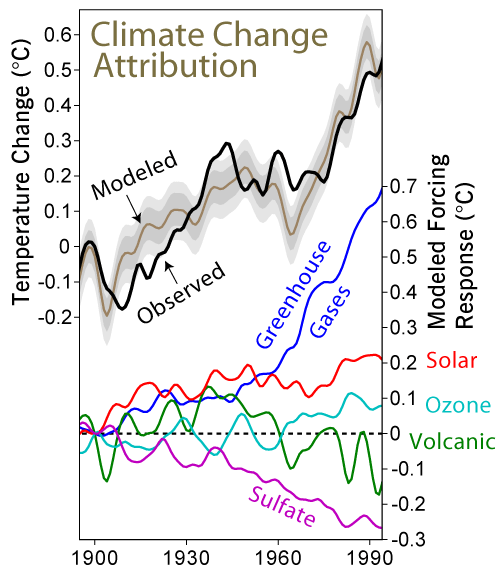Buffalo Roam
Registered Senior Member
So James can you explain why, the AGW Orthodoxy wants to dismiss;
Sun as major causal factor, vs: Anthropogenic Warming in the rise of temperatures.
http://www.tmgnow.com/repository/solar/lassen1.html
Space weather may also in the long term affect the Earth's climate. Solar ultra-violet, visible and heat radiation are the primary factors for the Earth's climate, including global average temperatures, and these energy sources appear to be quite constant. However, many scientists have observed corrrelations between the solar magnetic activity, which is reflected in the sunspot frequency, and climate parameters at the Earth. Sunspots has been recorded through several hundreds of years which makes it possible to compare their variable frequency to climate variations to the extent that reliable climatological records exists. One of the most striking comparisons was published by E. Friis-Christensen og K. Lassen, DMI, in "Science" in 1991. In their work they compared the average temperatureat the northern hemisphere with the average solar activity defined through the interval between successive sunspot maxima. The more active the sun - the shorter the interval: the solar cycle runs more intense. Their results are displayed in the figure below:

The red curve illustrates the solar activity, which is generally
increasing through an interval of 100 years, since the cycle length
has decreased from around 11.5 years to less than 10 years. Within
the same interval the Earth's average temperature as indicated by
the blue curve has increased by approximately 0.7 degree C. Even
the finer structures in the two curves have similar appearances.
(Reference: Friis-Christensen, E., and K. Lassen, Length of the solar
cycle: An indicator of solar activity closely associated with climate,
Science, 254, 698-700, 1991).
Reid (1987) noticed a certain amount of similarity of the secular variation in globally averaged sea-surface temperature (SST) over the past 130 years to the corresponding variation of solar activity as revealed by the envelope of the 11-year running mean sunspot number. He pointed out that the two time series had several features in common. Most noteworthy was the prominent minimum in the early decades of this century, the steep rise to a maximum in the 1950s, and a brief drop during the 1960s followed by a final rise. Based on this comparison Reid suggested that the solar irradiance may have varied by approximately 0.6 % from 1910 to 1960 in phase with the 70-90 year cycle (the Gleissberg period) of solar activity. He found that the necessary range of variation in the solar constant during the total 130 year period is less than 1%. Satellite measurements over approximately one solar cycle have shown that the irradiance is not constant, but model calculations show that it varies too little (less than 0.1 %) during a solar cycle to be of major importance for climate. However, no measurements yet exist that do exclude the possibility of larger variations in total irradiance over a longer period of time.
Friis-Christensen and Lassen (1991) pointed out a major difficulty with Reid's interpretation. They examined the northern hemisphere land air temperature and noted that this record was leading both the SST record and the sunspot record by as much as 20 years. From this discrepancy they concluded that if a cause and effect relation between solar activity and terrestrial climate is to be maintained, it is unlikely that long-term variations of solar activity can be sufficiently well represented by some average value of the sunspot number itself.
But as they pointed out there are other parameters of solar activity that indicate that the sunspot number is probably not necessarily also a good indicator of long-term changes. An example is the geomagnetic activity that is caused by the interaction between the solar wind and the geomagnetic field. There is a fundamental difference in the long-term behavior of the sunspot number and the geomagnetic activity (Fig.2).

Whereas the sunspot number returns to near zero at each 11-year minimum, the 11-year geomagnetic activity variations are superposed on a long-term variation of similar amplitude includinging a nearly monatomic increase from 1900 to 1950. This has been interpreted as a signature of an increase in the solar wind velocity through the century. The observed long-term variation in solar energy output by means of the solar wind suggests that similar long-term changes in other manifestations of solar energy output may have occurred.
So please explain the dismissal of the Sun and its activity, and cycles as a major causal factor in the Current Global Warming?
There is a demonstrable correlation between Sunspot activity, which leads to increases of solar energy output, which translates to increase temperatures on earth, approximately defined into 11 year cycles, along with periodicity of 70-90 years, which is the time line that has raised such concern among the AGW Orthodoxy.
Sun as major causal factor, vs: Anthropogenic Warming in the rise of temperatures.
http://www.tmgnow.com/repository/solar/lassen1.html
Solar Activity and Climate
Space weather may also in the long term affect the Earth's climate. Solar ultra-violet, visible and heat radiation are the primary factors for the Earth's climate, including global average temperatures, and these energy sources appear to be quite constant. However, many scientists have observed corrrelations between the solar magnetic activity, which is reflected in the sunspot frequency, and climate parameters at the Earth. Sunspots has been recorded through several hundreds of years which makes it possible to compare their variable frequency to climate variations to the extent that reliable climatological records exists. One of the most striking comparisons was published by E. Friis-Christensen og K. Lassen, DMI, in "Science" in 1991. In their work they compared the average temperatureat the northern hemisphere with the average solar activity defined through the interval between successive sunspot maxima. The more active the sun - the shorter the interval: the solar cycle runs more intense. Their results are displayed in the figure below:

The red curve illustrates the solar activity, which is generally
increasing through an interval of 100 years, since the cycle length
has decreased from around 11.5 years to less than 10 years. Within
the same interval the Earth's average temperature as indicated by
the blue curve has increased by approximately 0.7 degree C. Even
the finer structures in the two curves have similar appearances.
(Reference: Friis-Christensen, E., and K. Lassen, Length of the solar
cycle: An indicator of solar activity closely associated with climate,
Science, 254, 698-700, 1991).
Global temperature and sunspot number
Reid (1987) noticed a certain amount of similarity of the secular variation in globally averaged sea-surface temperature (SST) over the past 130 years to the corresponding variation of solar activity as revealed by the envelope of the 11-year running mean sunspot number. He pointed out that the two time series had several features in common. Most noteworthy was the prominent minimum in the early decades of this century, the steep rise to a maximum in the 1950s, and a brief drop during the 1960s followed by a final rise. Based on this comparison Reid suggested that the solar irradiance may have varied by approximately 0.6 % from 1910 to 1960 in phase with the 70-90 year cycle (the Gleissberg period) of solar activity. He found that the necessary range of variation in the solar constant during the total 130 year period is less than 1%. Satellite measurements over approximately one solar cycle have shown that the irradiance is not constant, but model calculations show that it varies too little (less than 0.1 %) during a solar cycle to be of major importance for climate. However, no measurements yet exist that do exclude the possibility of larger variations in total irradiance over a longer period of time.
Friis-Christensen and Lassen (1991) pointed out a major difficulty with Reid's interpretation. They examined the northern hemisphere land air temperature and noted that this record was leading both the SST record and the sunspot record by as much as 20 years. From this discrepancy they concluded that if a cause and effect relation between solar activity and terrestrial climate is to be maintained, it is unlikely that long-term variations of solar activity can be sufficiently well represented by some average value of the sunspot number itself.
But as they pointed out there are other parameters of solar activity that indicate that the sunspot number is probably not necessarily also a good indicator of long-term changes. An example is the geomagnetic activity that is caused by the interaction between the solar wind and the geomagnetic field. There is a fundamental difference in the long-term behavior of the sunspot number and the geomagnetic activity (Fig.2).

Whereas the sunspot number returns to near zero at each 11-year minimum, the 11-year geomagnetic activity variations are superposed on a long-term variation of similar amplitude includinging a nearly monatomic increase from 1900 to 1950. This has been interpreted as a signature of an increase in the solar wind velocity through the century. The observed long-term variation in solar energy output by means of the solar wind suggests that similar long-term changes in other manifestations of solar energy output may have occurred.
So please explain the dismissal of the Sun and its activity, and cycles as a major causal factor in the Current Global Warming?
There is a demonstrable correlation between Sunspot activity, which leads to increases of solar energy output, which translates to increase temperatures on earth, approximately defined into 11 year cycles, along with periodicity of 70-90 years, which is the time line that has raised such concern among the AGW Orthodoxy.


